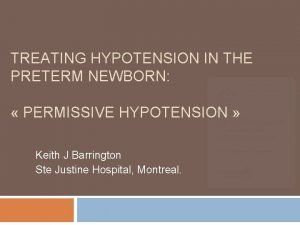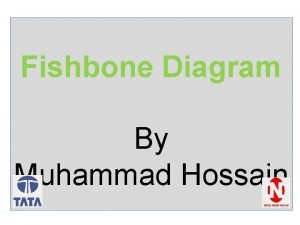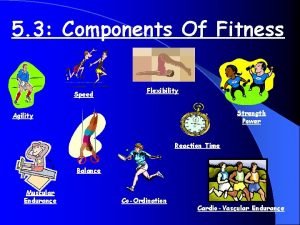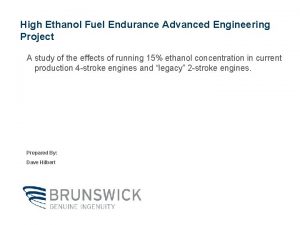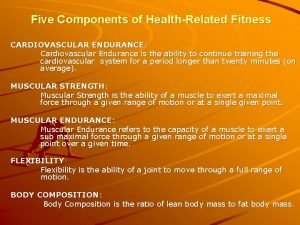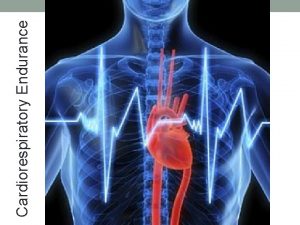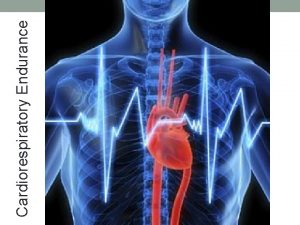Effect of low dose endurance training on heart




















- Slides: 20


Effect of low dose endurance training on heart rate variability at rest and during incremental maximal exercise test

Epidemiological studies provide evidence that recreational physical activity promotes and maintains health and that, regular endurance training provides additional health benefits, including a reduction of cardiovascular risk factors and mortality. (Bucksch and Schlicht 2006)

Endurance training induces central adaptations, including an increase in maximal cardiac output, stroke volume, and diastolic filling as well as peripheral adaptations in skeletal muscle. These adaptations are produced by a complex set of structural, metabolic, humeral and neural changes, including modifications of autonomic nervous system function. (Haskell et al. 2007)

One possible pathway by which endurance training benefits cardiovascular health is through causing a shift in autonomic HR control towards increased vagal dominance. The relative bradycardia observed in highly trained endurance athletes may result from an increase in vagal tone and/or decrease in sympathetic tone or, alternatively, from a decrease in intrinsic HR. (Pichon et al. 2004)

Longitudinally, the dose-response relation between a training stimulus (i. e. , the intensity, duration & frequency of training) and autonomic cardiac adaptation has remained uncertain. (Bucksch and Schlicht 2006)

Furthermore, there is limited information about the minimal amount of endurance training required to provide a sufficient training stimulus to induce health benefits by improving autonomic balance and physical fitness. (Bucksch and Schlicht 2006)

Spectral analysis of heart rate variability (HRV) provides a non-invasive measure of autonomic HR control. Two frequency components are usually examined: High Frequency Power (HFP), reflecting vagal effects on the heart, and Low Frequency Power (LFP), reflecting combined vagal and sympathetic effects on the heart (Kaikkonen et al. 2007)

Until recently, HRV analysis has been restricted to settings of a steady-state HR, and, therefore, the majority of HRV studies have obtained information about autonomic HR control only at rest. (Martinmäki et al. 2006)

However, a recently developed timefrequency analysis method, short-time Fourier transform (STFT), can be applied to non steady-state HR settings and it provides a promising tool for estimating transient changes in autonomic HR control. (Martinmäki and Rusko 2008)

According to recent review articles, most cross-sectional studies have concluded that endurance training induces a decrease in HR and an increase in HRV at rest. (Achten and Jeukendrup 2003; Aubert et al. 2003)

Results from longitudinal studies on young and middle aged subjects have been less conclusive. Some studies have found a decrease in resting HR combined with an increase in HFP after endurance training. (Carter et al. 2003; Mourot et al. 2004)

Others have found no change in either HFP or LFP after endurance training. Only a few studies have examined the effects of endurance training on HRV during exercise. Endurance training has been reported to induce an increase in both LFP and HFP components. (Leicht et al. 2003)

Martinmäki et al. 2008 designed a study to evaluate the effects of endurance training on autonomic HR control at rest and during exercise at different intensities in previously 11 untrained male subjects.

Total, low and high frequency power of HRV were computed by short-time Fourier transform (STFT) at rest as well as during and after an incremental maximal exercise test prior to a 7 -week preparatory period and prior to and following a low-dose 14 -week endurance training period.

The endurance training period included low to high intensity exercise twice a week in order to clarify whether the lowdose endurance training would have any beneficial effects on autonomic HR control.

The preparatory period induced no change in aerobic power or HRV. The endurance training period increased peak aerobic power by 12%, decreased the HR and increased all HRV indices at absolute sub-maximal exercise intensities, but not at rest.

Taken together, these findings showed that the low-dose endurance training program induced changes in autonomic HR control during exercise. The training-induced lower HR was accompanied by greater HFP at the sub maximal exercise intensity levels.

This supports that the lower HR resulted from increased vagal HR control during sub maximal ex’s following endurance training. However, we cannot exclude that the training-induced lowering in HR during exercise may have been partly due to a decrease in sympathetic HR control.

Thank You
 Increase bp
Increase bp Hologic's low dose 3d mammography
Hologic's low dose 3d mammography Macrobid epocrates
Macrobid epocrates Mid = (low + high) / 2
Mid = (low + high) / 2 Supportive communication style
Supportive communication style Low accuracy low precision
Low accuracy low precision Low voltage hazards
Low voltage hazards Fishbone diagram for customer satisfaction
Fishbone diagram for customer satisfaction Differentiate muscular strength from muscular endurance
Differentiate muscular strength from muscular endurance Tinman warm up
Tinman warm up Let us run with endurance the race that is set before us
Let us run with endurance the race that is set before us What is endurance?
What is endurance? Abb dry type transformer
Abb dry type transformer Fitt table muscular strength and endurance
Fitt table muscular strength and endurance Bank angle and load factor
Bank angle and load factor Mcgill's torso muscular endurance test battery
Mcgill's torso muscular endurance test battery Components of fitness speed
Components of fitness speed Claire cannon
Claire cannon Haydee endurance test
Haydee endurance test What is cardiovascular endurance in health related fitness
What is cardiovascular endurance in health related fitness Haydee endurance test
Haydee endurance test
